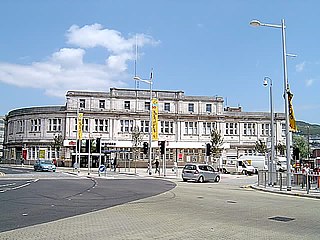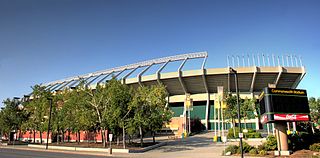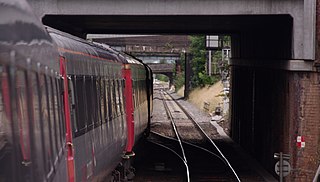Related Research Articles
Valleys & Cardiff Local Routes is the network of passenger suburban railway services radiating from Cardiff, Wales. It includes lines within the city itself, the Vale of Glamorgan and the South Wales Valleys.

Edgware Road is a London Underground station on the Circle, District and Hammersmith & City lines, located on the corner of Chapel Street and Cabbell Street, within Travelcard zone 1. A separate station of the same name but served by the Bakerloo line is located about 150 metres away on the opposite side of Marylebone Road.

St Kilda East is a suburb in Melbourne, Victoria, Australia, 6 km south-east of Melbourne's Central Business District, located within the Cities of Glen Eira and Port Phillip local government areas. St Kilda East recorded a population of 12,571 at the 2021 census.

State Route 120 is an east–west state highway in the northwestern portion of the U.S. state of Ohio. Its western terminus is at the Michigan state line, where an unnumbered county highway continues west-northwest. State Route 120’s eastern terminus is in Toledo at State Route 65; the route is, for all practical purposes, a spur of U.S. Route 20, which generally bypasses Toledo to the west and south.

Shoeburyness railway station is the eastern terminus of the London, Tilbury and Southend Line, serving the suburb of Shoeburyness, Essex. It is 39 miles 40 chains (63.57 km) down the main line from London Fenchurch Street via Basildon; the preceding station is Thorpe Bay. Its three-letter station code is SRY.

Southend Central railway station is on the London, Tilbury and Southend line and is one of two primary stations serving the city of Southend-on-Sea, Essex. The city's other main station is called Southend Victoria which is the terminus of a branch line off the Great Eastern Main Line. Southend Central is 35 miles 55 chains (57.43 km) down the line from London Fenchurch Street via Basildon and it is situated between Westcliff and Southend East stations. Its three-letter station code is SOC.

The Union Pacific West Line (UP-W) is a Metra commuter rail line operated by Union Pacific Railroad in Chicago, Illinois and its western suburbs. Metra does not refer to its lines by particular colors, but the timetable accents for the Union Pacific West line are "Kate Shelley Rose" pink, honoring an Iowa woman who saved a Chicago & North Western Railway train from disaster in 1881. Green and yellow were already selected for the Union Pacific North Line and Union Pacific Northwest Line, respectively, so pink was chosen for this line. Therefore, the UP-W is the only Metra line that uses a color to honor a person instead of a fallen flag railroad. Until the late 1940s the line had a branch to Freeport, Illinois. It diverged from the main line at West Chicago and had stations at Elgin, Marengo, Belvidere, Rockford, Freeport, and other communities. The line was once known as the Chicago & Northwestern/West Line until UP took over the C&NW in 1995. All Metra trains on this line terminated at Geneva until 2006, when the line was extended to its present terminus in Elburn. The line runs as part of the Union Pacific Railroad's Geneva Subdivision.

Connecticut Avenue is a major thoroughfare in the Northwest quadrant of Washington, D.C., and suburban Montgomery County, Maryland. It is one of the diagonal avenues radiating from the White House, and the segment south of Florida Avenue was one of the original streets in Pierre (Peter) Charles L'Enfant's plan for Washington. A five-mile segment north of Rock Creek was built in the 1890s by a real-estate developer.

Swansea railway station serves the city of Swansea, Wales. It is 216 miles 7 chains (348 km) measured from London Paddington on the National Rail network.

Los Angeles Metro Bus is the transit bus service in Los Angeles County, California operated by the Los Angeles County Metropolitan Transportation Authority (Metro). In 2023, the system had a ridership of 222,919,700, or about 710,100 per weekday as of the first quarter of 2024.

Larne Harbour railway station, Larne, County Antrim, Northern Ireland, serves the ferry port for ferries to Cairnryan. There are also occasional sailings to Douglas, Isle of Man in conjunction with the Isle of Man TT. Sailings to Cairnryan are operated by conventional ships and several crossings a day operate in each direction throughout the year.

Downtown Paterson is the main commercial district of Paterson, Passaic County, in the U.S. state of New Jersey. The area is the oldest part of the city, along the banks of the Passaic River and its Great Falls. It is roughly bounded by Interstate 80, Garret Mountain Reservation, Route 19, Oliver Street, and Spruce Street on the south; the Passaic River, West Broadway, Cliff Street, North 3rd Street, Haledon Avenue, and the borough of Prospect Park on the west; and the Passaic River also to the north.

McCauley is an ethnically diverse inner city neighbourhood in Edmonton, Alberta, undergoing revitalization. It is named for Matthew McCauley, the first mayor of Edmonton, and is located just to the north east of the Downtown core. McCauley is known as the home of religious buildings in a small area, as well as being a large venue for the 1978 Commonwealth Games.

The Port of Manila refers to the collective facilities and terminals that process maritime trade function in harbors in Metro Manila. Located in the Port Area and Tondo districts of Manila, facing Manila Bay, it is the largest and the premier international shipping gateway to the country. The Philippine Ports Authority, a government-owned corporation, manages the Port of Manila and most of the public ports in the country. It is composed of 3 major facilities, namely Manila North Harbor, Manila South Harbor, and the Manila International Container Terminal.

The Camp Hill line is a railway line in Birmingham between Kings Norton on the Cross-City Line and Birmingham New Street via Grand Junction on the main lines from Derby and Coventry. The line was once the terminal approach of the Birmingham and Gloucester Railway to Curzon Street before it was incorporated into the Midland Railway.
The Albion–Jacana line is a railway line in the western suburbs of Melbourne, Australia. Linking Albion on the Sunbury line to Jacana on the Craigieburn line, it is primarily used by freight trains and has no overhead wires, passenger stations or platforms.
A through service is a concept of passenger transport that involves a vehicle travelling between lines, networks or operators on a regularly specified schedule, on which the passenger can remain on board without alighting. It may be in form of either the following:

Madison Street is a major thoroughfare of Seattle, Washington. The street originates at Alaskan Way on the Seattle waterfront, and heads northeast through Downtown Seattle, First Hill, Capitol Hill, Madison Valley, Washington Park, and Madison Park, ending just east of 43rd Avenue East on Lake Washington. From Broadway to Lake Washington, the street is known as East Madison Street, which accounts for most of its length. It is the only Seattle street that runs uninterrupted from the salt water of Puget Sound in the west to the fresh water of Lake Washington in the east.

Tartu railway station is the main railway station in Tartu, Estonia.

Broadway Avenue is a road in Cuyahoga County in the U.S. state of Ohio. Broadway begins in Downtown Cleveland at Carnegie Avenue as a continuation to the south of Ontario Street. It runs from northwest to southeast through the cities of Cleveland, Garfield Heights, Maple Heights, Bedford, and the village of Oakwood. Its southern terminus is at the southern boundary of Cuyahoga County where it intersects Richmond Road and continues to the southeast into Summit County as Ravenna Road.
References
- ↑ "Archived copy". Archived from the original on 2014-08-13. Retrieved 2014-08-14.
{{cite web}}: CS1 maint: archived copy as title (link) - 1 2 The Street Railway Journal. Street Railway Publishing Company. 1898.
- ↑ "Archived copy". Archived from the original on 2014-08-13. Retrieved 2014-08-14.
{{cite web}}: CS1 maint: archived copy as title (link)